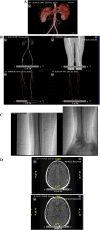Psychiatric sequelae of thromboangiitis obliterans: a case report and review of the literature
- PMID: 36717929
- PMCID: PMC9885629
- DOI: 10.1186/s13256-022-03694-z
Psychiatric sequelae of thromboangiitis obliterans: a case report and review of the literature
Abstract
Background: Peripheral manifestations secondary to progressive vascular occlusions are characteristic of the rare condition termed thromboangiitis obliternas (TAO) or Buerger's disease. The central manifestations of this disease are however poorly characterized, particularly those of psychiatric nature, and their prevalence is largely unknown. Speculations have been made around the polymorphic nature and triggers of observed psychopathology in TAO; much however remains to be unraveled in this area.
Case presentation: We present the case of a 33-year-old Caucasian male who developed first episode of psychosis at the age of 29 years. There was no history of previous mental illness either in the patient, or in any of his family members. He had been a long- term heavy smoker and was experiencing progressive lower limb claudication since the age of 22 years; however, all inflammatory, autoimmune and atherosclerotic markers were negative. His psychosis was characterized by retention of a warm affect, and despite some amelioration, was generally resistant to a fair trial of several anti-psychotic medications including Clozapine.
Conclusion: The pathophysiology of psychosis secondary to Buerger's is not yet well characterized which adds to the complexity of managing these cases. Recognizing that cerebral manifestations of this disease may evolve several years after the onset of peripheral thromboangiitic features is important for following the natural history and considering measures that may reduce the burden of illness.
Keywords: Buerger's disease and schizophrenia-like-psychosis; Case report; Thromboangiitis obliterans inducing psychosis; Treatment resistant organic psychosis.
© 2022. Crown.
Conflict of interest statement
The authors declare that they do not have any competing interests.
Figures


References
-
- von Winiwarter F. Ueber eine eigenthümliche Form von Endarteriitis und Endophlebitis mit Gangrän des Fusses. Arch Klin Chir. 1879;23:202–226.
-
- Shionoya S. Buerger's disease: pathology, diagnosis and treatment. Nagoya: University of Nagoya Press; 1990. p. 1990.
Publication types
MeSH terms
LinkOut - more resources
Full Text Sources

